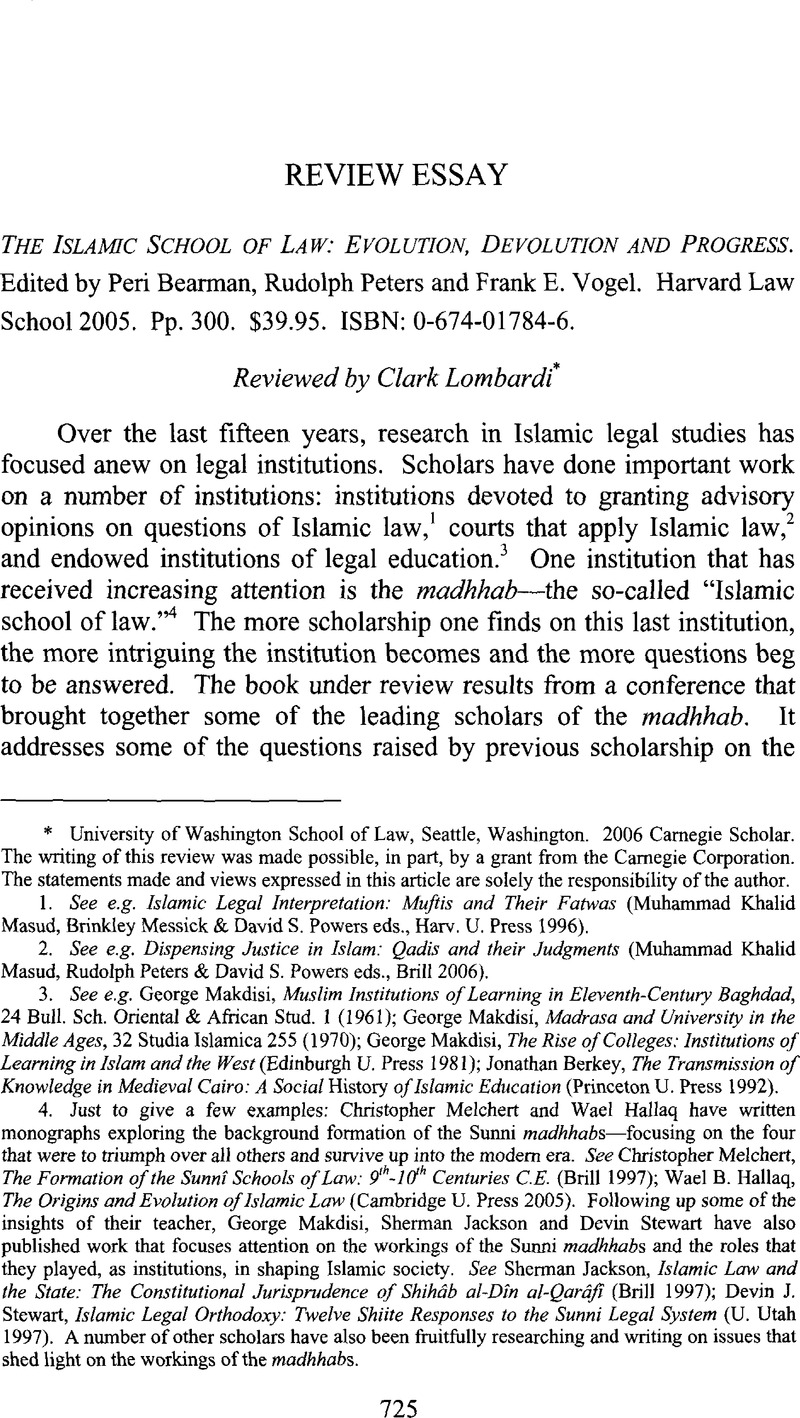No CrossRef data available.
Article contents
The Islamic School of Law: Evolution, Devolution and Progress. Edited by Bearman Peri, Peters Rudolph and Vogel Frank E.. Harvard Law School2005. Pp.300. $39.95. ISBN: 0-674-01784-6.
Published online by Cambridge University Press: 24 April 2015
Abstract

- Type
- Review Essay
- Information
- Copyright
- Copyright © Center for the Study of Law and Religion at Emory University 2008
References
1. See e.g. Islamic Legal Interpretation: Muftis and Their Fatwas (Masud, Muhammad Khalid, Messick, Brinkley & Powers, David S. eds., Harv. U. Press 1996)Google Scholar.
2. See e.g. Dispensing Justice in Islam: Qadis and their Judgments (Masud, Muhammad Khalid, Peters, Rudolph & Powers, David S. eds., Brill 2006)Google Scholar.
3. See e.g. Makdisi, George, Muslim Institutions of Learning in Eleventh-Century Baghdad, 24 Bull. Sch. Oriental & African Stud. 1 (1961)CrossRefGoogle Scholar; Makdisi, George, Madrasa and University in the Middle Ages, 32 Studia Islamica 255 (1970)CrossRefGoogle Scholar; Makdisi, George, The Rise of Colleges: Institutions of Learning in Islam and the West (Edinburgh U. Press 1981)Google Scholar; Berkey, Jonathan, The Transmission of Knowledge in Medieval Cairo: A Social History of Islamic Education (Princeton U. Press 1992)CrossRefGoogle Scholar.
4. Just to give a few examples: Christopher Melchert and Wael Hallaq have written monographs exploring the background formation of the Sunni madhhabs—focusing on the four that were to triumph over all others and survive up into the modern era. See Melchert, Christopher, The Formation of the Sunni Schools of Law: 9th-10th Centuries C.E. (Brill 1997)Google Scholar; Hallaq, Wael B., The Origins and Evolution of Islamic Law (Cambridge U. Press 2005)Google Scholar. Following up some of the insights of their teacher, George Makdisi, Sherman Jackson and Devin Stewart have also published work that focuses attention on the workings of the Sunni madhhabs and the roles that they played, as institutions, in shaping Islamic society. See Jackson, Sherman, Islamic Law and the State: The Constitutional Jurisprudence of Shihdb al-Din al-Qarâfi (Brill 1997)Google Scholar; Stewart, Devin J., Islamic Legal Orthodoxy: Twelve Shiite Responses to the Sunni Legal System (U. Utah 1997)Google Scholar. A number of other scholars have also been fruitfully researching and writing on issues that shed light on the workings of the madhhabs.
5. For a partial list of monographs, see supra n. 3. A more complete list of articles is included in the bibliography to this book.
6. See Masud, Peters & Powers, Dispensing Justice in Islam, supra n. 2.
7. It is easy to understand why the editors chose to do this. What time was not spent on writing an introductory article was clearly well used. As noted already, this is an extremely polished work. The editors obviously spent a great deal of time selecting and editing a particularly rich group of articles. As it is likely that most readers will be Islamicists, it seems a perfectly reasonable choice to present them in polished form without taking the time to give information that for most readers will be unnecessary. Precisely because the articles are so good and the book so polished, it would seem a shame if non-experts who are otherwise willing to engage with these articles find themselves unable to do so because they have too little context to make sense of them.
8. See Wheeler, Brannon, Applying the Canon in Islam: The Authorization and Maintenance of Interpretive Reasoning in Hanafi Scholarship (SUNY Press 1996)Google Scholar.
9. See Sherman Jackson, Islamic Law and the State, supra n. 4.
10. See generally Stewart, Islamic Legal Orthodoxy, supra n. 4.
11. See e.g. Messick, Brinkley, The Mufti, the Text and the World: Legal Interpretation in Yemen, 21 Man 102–119 (1986)CrossRefGoogle Scholar; Muhammad Khalid Masud, Brinkley Messick & David S. Powers, Muftis, Fatwas and Islamic Legal Interpretation, supra n. 1, at 3-32; Brinkley Messick, Media Muftis: Radio Fatwas in Yemen, supra n. 1, at 310-320.




